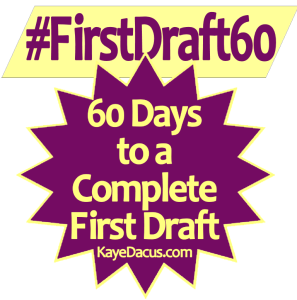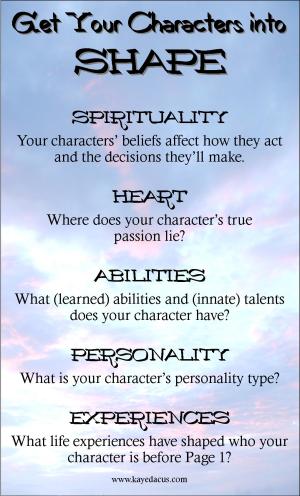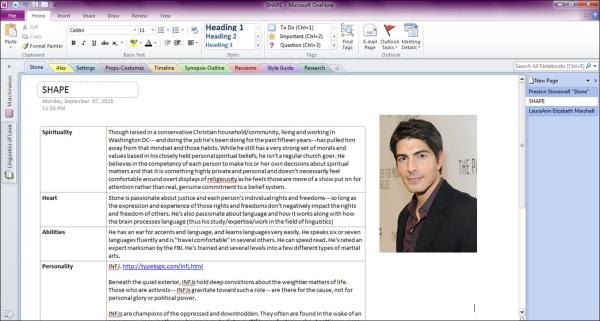#FirstDraft60 Day 8 — Getting Your Characters into S.H.A.P.E.
 Yesterday, we determined who our main characters are and what POV we’ll be using in our stories. Today, we’re going to go deeper with our characters and chart out who they are as people.
Yesterday, we determined who our main characters are and what POV we’ll be using in our stories. Today, we’re going to go deeper with our characters and chart out who they are as people.
When I start developing a story idea and know who at least one of the main characters is, the first thing I do is figure out where that character came from—literally and figuratively. I know that many people use character “interviews” or worksheets to do this; I write it out like a synopsis, letting the ideas flow as I write and the questions rise as they may. Part of this is figuring out who/what a character is, inside.
When working with a series in which my main character appeared in other books as a secondary character, I start by going back and making notes (if I didn’t already) of everything mentioned about this person (goes for physical description as well) and his or her background, personality, demeanor, reactions, actions, schooling, friends, work, etc. When working with new characters, I like to use a technique I actually learned on a church retreat.
Get Your Characters into S.H.A.P.E.
 Here’s a surefire way to figure out who your characters are, which does go hand-in hand with figuring out their backstory, which we’ll be working on later this week. But today, we’re going to work on getting our characters into S.H.A.P.E.:
Here’s a surefire way to figure out who your characters are, which does go hand-in hand with figuring out their backstory, which we’ll be working on later this week. But today, we’re going to work on getting our characters into S.H.A.P.E.:
– SPIRITUALITY: Not just for those writing Christian or inspirational fiction, this is something important for all writers to know about all of your main characters, because the characters’ morals and values, and thus their actions, reactions, and decision making, will hinge on what they believe about life and the afterlife and the value of both.
– HEART: What is your character passionate about? What are his desires? Her goals? What does she want to do with her life? What does he want to accomplish by the time he’s 30, 50, 70?
– ABILITIES: This goes beyond their physical abilities (walk, run, talk, etc.). What have they learned to do? Is she a Victorian girl who’s learned to use a typewriter in hopes of getting a job to support herself instead of marrying someone she doesn’t love? Has he learned to train guard dogs and police canines? But then, what are their inborn talents? Those things with which we would say he or she is “gifted”?
– PERSONALITY: What is your character’s personality type? This is where you can really have fun. Find out your character’s Meyers-Briggs type by taking the test as your character. If you don’t want to take the test, you can read about personality types. Introverts and Extroverts “recharge” differently and react differently in public and private settings. Thinkers and Feelers come to decisions in totally different ways. And so on. Make your character more dimensional by giving him or her a complete personality.
– EXPERIENCES: What are your character’s life experiences? What have your characters been through in their lives to make them who they are when they step onto Page 1 of your story? This is the bulk of the backstory, which everything else plays off of and is affected by. This part makes a really good lead-in to writing out the characters backstory, because it can include:
- – Family makeup/background. What size family does he come from? How many siblings? Were both parents present? Did she have a good relationship with them? What was his relationship with his siblings like? Did she love her family or could she not wait to escape? And so on.
– Education. Whether formal or self-taught, one’s education is crucial to who they are as a person. Did they have all the benefits of an upper-class private/Ivy League education? The scrappier, American-dream public school education? Or maybe she had to drop out in eighth grade and go to work to support the family. And even if someone went to school and got a college degree, that doesn’t make them “intelligent” or “learned.” That just means that they have a couple of pieces of paper. How intellectual is your character? How smart? How street-smart? How wise? How knowledgeable? How does this compare to the people around him/her?
– Favorites. Color, food, music, entertainment, etc. What are the things that give your character a good quality of life? (Or would if they had access to them.) Get creative and have fun with these.
And here’s the example of Stone’s S.H.A.P.E. page in my Story Bible:

Once you have all of this down you should have a good understanding of who your character is. The reason I try to figure as much of this out before writing is that it saves me time in revision after finishing the first draft if I don’t have to go back and edit out long stream-of-consciousness scenes in which I’m inside the character’s head digging into backstory I didn’t know before I started writing. But no matter how detailed I get with this, I always have a few revelations about my characters—things I never would have known about them until they were faced with a crisis and forced to own up to something from the past they kept deeply hidden, even from me.
Assignment: Create and complete, as best as you can, a S.H.A.P.E. chart for each of your main/viewpoint characters in your Story Bible.
FOR DISCUSSION:
How will figuring out the S.H.A.P.E. of your character(s) help you in developing your story?

Just wanted to let you know that I’ve been following along, but have been too busy to comment. Thought I should just say Thank You so much for doing this!!
LikeLiked by 1 person
Character development is my favorite part of the planning process. Figuring out the S.H.A.P.E. of the characters will help develop almost every part of my story. Since my story is from a First person POV practically every bit of information relayed is dependent on knowing my protagonist – how she would perceive situations and other characters as well as how she will act and react.
LikeLiked by 1 person
The personality survey is always one of my favorite parts of character development. But I’m weird that way! 😀
LikeLike
I almost always learn something new about myself while putting new characters through the S.H.A.P.E. process. It makes me admit who I am and why I think/believe certain ways (and what I think and believe) as I determine what makes my characters tick and how they will be challenged throughout the course of the story.
LikeLike
In addition to other stuff (spirituality, passions, etc.), I have discovered that Stone is INFJ and Alex is ESTJ.. Mainly because these personality types fit very well with what the S, H, and A aspects of their characters told me about them:
Stone–“INFJs are champions of the oppressed and downtrodden. They often are found in the wake of an emergency, rescuing those who are in acute distress . . . suspicious of others’ motives . . . selective about their friends . . . knack for fluency in language and facility in communication” [he is a linguist, after all!] “not easily led . . . nonverbal sensitivity enables the INFJ to know and be known by others intimately.”
Alex–“ESTJs thrive on order and continuity . . . enjoy organizing and mobilizing people . . . seek out like-minded companions in clubs, civic groups, churches, and other service organizations” [writers’ groups!] “family is likewise a central focus, and attendance at such events as weddings, funerals, and family reunions is obligatory . . . love to provide and receive good service . . . acute sense for orthodoxy. Much of their evaluation of persons and activities reflects their strong sense of what is ‘normal’ and what isn’t . . . promote the work ethic . . . not afraid to stand up for what she believes is right, even in the face of overwhelming odds.”
LikeLiked by 1 person